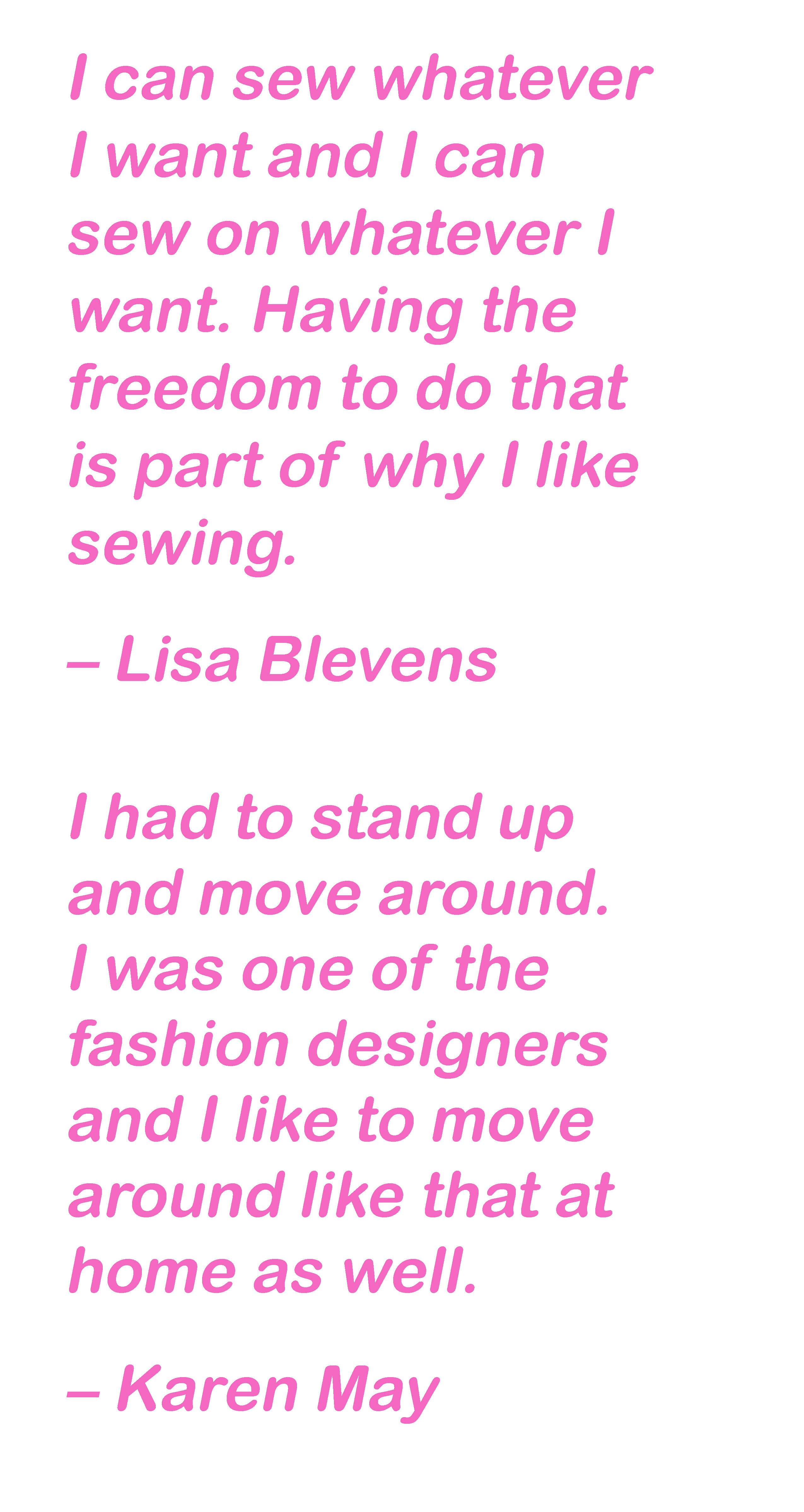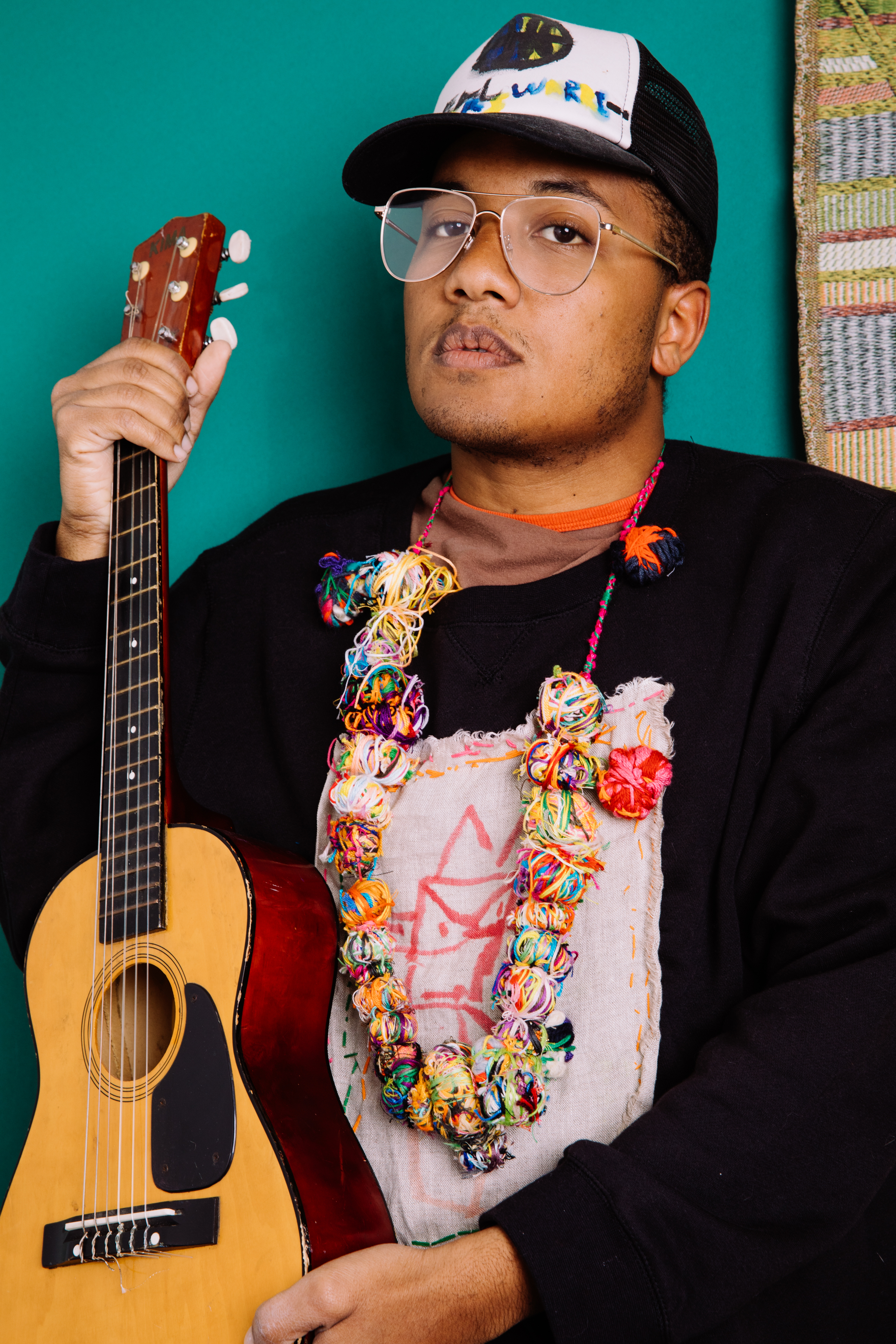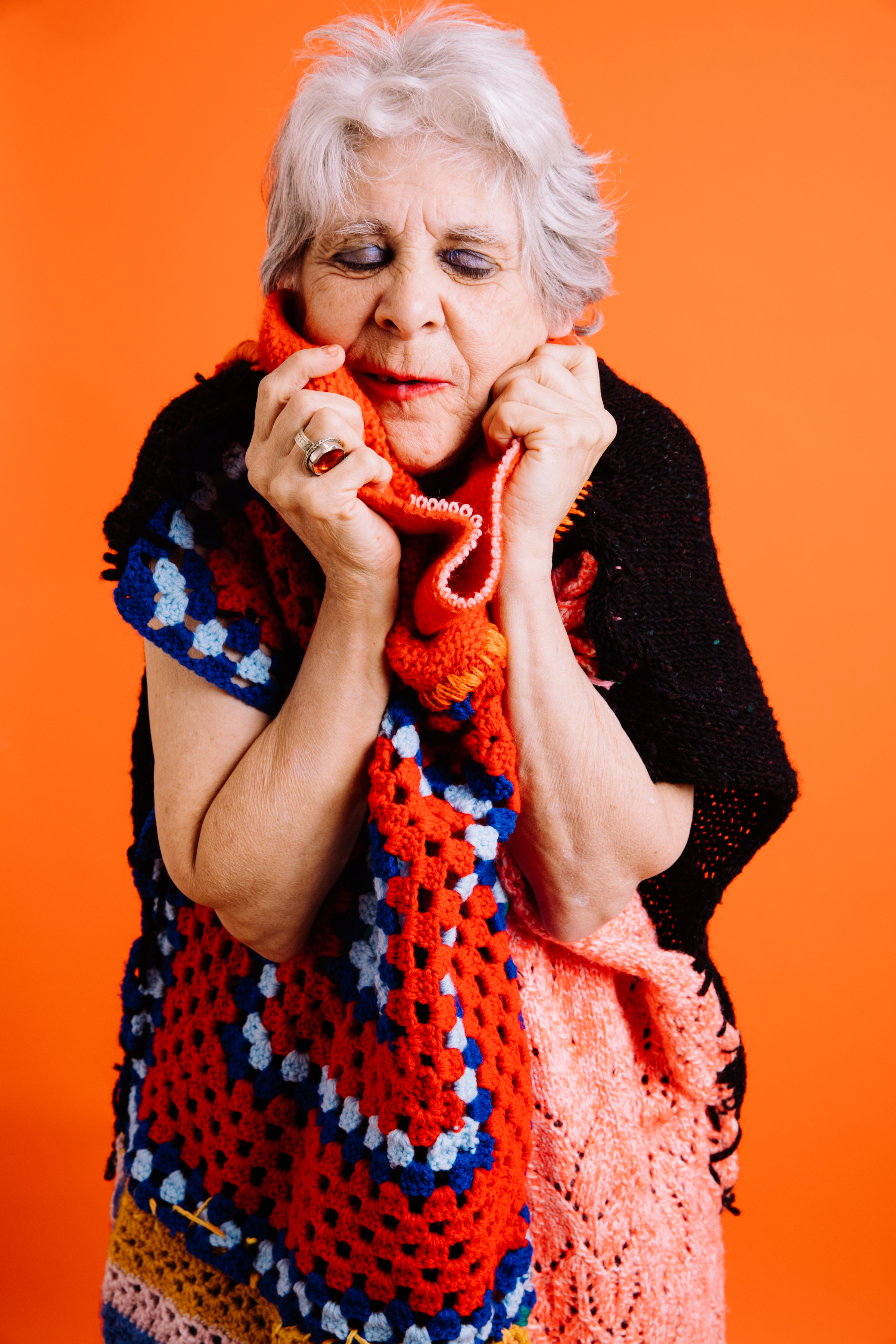

Fashion as Communication, Celebration and Challenge: NIAD’s Me and My Girl
Nan Collymore in conversation with Paulina Berczynski
“The construction of clothing became a vessel through which we could observe our own bodies and identities, ways to use art theory and textile knowledge-sewing, appliqué, fabric painting, styling, and collecting. And from this exploration came the idea to produce something that could concretize the many shapes and forms that the work was taking into a more formalistic presentation.”
A few years back, Feral Fabric led a backpatch workshop at NIAD art center in Richmond, CA. We had already been fans of the art center, which supports adult artists with disabilities through a studio program and gallery among other offerings. But being inside their giant studios, filled to the brim with art materials, cool reference books, and all manner of work done by so many exceptional local artists, we were truly inspired. We also noted their giant fabric stash, lining an entire back wall of the studio.
During the pandi times, we met virtually with NIAD’s Studio Manager Nan Collymore to brainstorm about potential programming and gush about the power of textiles as a medium for creativity and exchange. It was during these talks that we learned about NIAD’s forthcoming fashion book Me and My Girl, featuring designs created and modeled by NIAD artists. Scheduled for release this summer, the book‘s title came from NIAD artist Karen May, who Collymore described as “a wonderful poet/orator of the magical,” which is fitting, as what we’ve seen of the book vibrates with poetry and magic, plus color, texture and so much positive, embodied attitude.
The advance photographs of the models/artists and their work were of particular interest to me since I have worked as a fashion designer, designing clothes and marketing, and styling photoshoots and the like for my independent brand for over 15 years. I was struck by what NIAD had acheived in this book, which to me looked like a perfect mix of the language of high fashion and a simultaneous challenge to that form.
Fashion is intrinsically about the body, of course, but so much about fashion is also about image. And in documenting a project like this to be published in book form, so much comes down to a unifying concept, energy, and attitude. For the Body Issue of Feral Fabric’s Journal, I decided to send Collymore a few questions about putting this massive project together.
![]()
PZB The first words that came to my mind looking through these photos were tactility, identity, styling - the feeling of tactility was especially reinforced through the text captions on some of the photo pages. To see this very saturated and rich image accompanied by equally rich descriptive text really reinforced the sumptuousness of the images for me.
I'm curious about the ideas behind the styling that lead to all of this over-the-top richness. The velvet, the color, the props and poses. As a co-stylist on this project can you say more about you and your co-stylist's ideas and concepts in styling these scenes? Were any of these choices made in collaboration with the models or designer/artists and if so I'd love to hear about their ideas. There are so many decisions that go into creating images like these, and into the project more broadly.
NC Yes, absolutely! The work is incredibly tactile. In the NIAD studio we are often working in ways that promote the touching of material- sorting through the fabric bins, unravelling yarn together, gathering, sharing. One of the aims of the book is to hopefully translate some of that studio experience onto the page and re-create those daily moments of touch.
The styling of the work was really an idea that the artists, Luce Iris (my daughter) and I came up with. In class, we’ve been using fashion magazines as inspiration. During our studio Artist of The Month exhibition of individual artist’s curatorial ideas, Shantae Robinson and Karen May used the system of tear sheets for the
wall. Many of the pages pulled were of extravagantly dressed models in bold colors, so we used this and Alessandro Michele’s palette as a template for the shoot. We collected vintage bags and old spectacles from estate sales and I had a lot of pieces hanging out in my closet. Many of the pieces that were included in the shoot have bold backgrounds like the Shantae Robinson hot pink dress that Raven Harper wears. We wanted to really take advantage of those colors by going with a maximalist approach to the styling. The artists often selected the pieces they wanted to wear. Luce Iris and I assisted.
During the pandi times, we met virtually with NIAD’s Studio Manager Nan Collymore to brainstorm about potential programming and gush about the power of textiles as a medium for creativity and exchange. It was during these talks that we learned about NIAD’s forthcoming fashion book Me and My Girl, featuring designs created and modeled by NIAD artists. Scheduled for release this summer, the book‘s title came from NIAD artist Karen May, who Collymore described as “a wonderful poet/orator of the magical,” which is fitting, as what we’ve seen of the book vibrates with poetry and magic, plus color, texture and so much positive, embodied attitude.
The advance photographs of the models/artists and their work were of particular interest to me since I have worked as a fashion designer, designing clothes and marketing, and styling photoshoots and the like for my independent brand for over 15 years. I was struck by what NIAD had acheived in this book, which to me looked like a perfect mix of the language of high fashion and a simultaneous challenge to that form.
Fashion is intrinsically about the body, of course, but so much about fashion is also about image. And in documenting a project like this to be published in book form, so much comes down to a unifying concept, energy, and attitude. For the Body Issue of Feral Fabric’s Journal, I decided to send Collymore a few questions about putting this massive project together.

PZB The first words that came to my mind looking through these photos were tactility, identity, styling - the feeling of tactility was especially reinforced through the text captions on some of the photo pages. To see this very saturated and rich image accompanied by equally rich descriptive text really reinforced the sumptuousness of the images for me.
I'm curious about the ideas behind the styling that lead to all of this over-the-top richness. The velvet, the color, the props and poses. As a co-stylist on this project can you say more about you and your co-stylist's ideas and concepts in styling these scenes? Were any of these choices made in collaboration with the models or designer/artists and if so I'd love to hear about their ideas. There are so many decisions that go into creating images like these, and into the project more broadly.
NC Yes, absolutely! The work is incredibly tactile. In the NIAD studio we are often working in ways that promote the touching of material- sorting through the fabric bins, unravelling yarn together, gathering, sharing. One of the aims of the book is to hopefully translate some of that studio experience onto the page and re-create those daily moments of touch.
The styling of the work was really an idea that the artists, Luce Iris (my daughter) and I came up with. In class, we’ve been using fashion magazines as inspiration. During our studio Artist of The Month exhibition of individual artist’s curatorial ideas, Shantae Robinson and Karen May used the system of tear sheets for the
wall. Many of the pages pulled were of extravagantly dressed models in bold colors, so we used this and Alessandro Michele’s palette as a template for the shoot. We collected vintage bags and old spectacles from estate sales and I had a lot of pieces hanging out in my closet. Many of the pieces that were included in the shoot have bold backgrounds like the Shantae Robinson hot pink dress that Raven Harper wears. We wanted to really take advantage of those colors by going with a maximalist approach to the styling. The artists often selected the pieces they wanted to wear. Luce Iris and I assisted.

PZB What we wear affects the way we project our identities to the world. The models are also projecting a lot in these images - attitude and identity. Many of these photos feel at once celebratory and composed, like a formal portrait taken at a fun party. I love the feel of these images and I am curious about how the artists experienced the process of designing these garments/wearables, modeling them, and otherwise helping to realize this project.
NC Yes I agree. As practicing artists, in the studio we are often wearing clothing that’s appropriate for that setting and this was an opportunity to get really dressed up, to celebrate and draw out the beauty in ourselves. My colleague, Shantanice Jones was the make-up artist and she worked with the artists in determining which colors they wanted to wear and whether they wanted to wear make-up at all. You know make-up is often seen as ‘mask’. But here we worked to make sure it was an embellishment and a device to draw out the beauty in each artist as well as a way to accentuate the garments.
This was an opportunity to get really dressed up,
to celebrate and draw out the beauty in ourselves.
The fashion shoot followed an intimate in-house fashion show that we held in the studio. On both occasions the artists described how beautiful and noticed they felt. Several months prior another colleague, Terri Moore, led a workshop in the art of make-up application. The artists were thrilled with transforming themselves through simple gestures and the undeniable relationship that painting one's face has to painting a canvas. These moments were obviously before COVID-19 hit and I think we’re all so grateful to have shared space in that way.




PZB The quote you sent from the book said, "The construction of clothing became a vessel through which we could observe our own bodies and identities." When I look at the pages of the book that you sent ahead for publication in our journal, I see the models’ bodies but I see so much more - identity, personality, and of course the designs and outfits themselves. Can you say more about how any of the designers worked with or against the body in their work?
NC The body is something we are working with and against in the studio, thinking about how differently bodies move in and around space. There’s the practice of making each body comfortable at work. But there’s also the idea of how we interpret the body in our work. The clothing structures that the artists make are following some of the rubric used in the fashion system, for instance draping on a dress form. But they are also working against that because the fashion industry works against so many bodies. There has been a heightened exposure of “difference” on the catwalk more recently, but there is still so far to go when it comes to a broader and honest representation of the body. I hope that by creating this working space in the studio, we are opening up the channels of communication that the fashion system has shut down. They’re artists and what they are making is an interpretation of clothing that isn’t necessarily meant to be worn, but can be displayed on walls or draped and framed.
The artists are making work in ways that are both abstract and figurative as well as in response to other art historical figures. Sometimes the work is evocative of a memory from their past, or it’s a symbol of their identity—their family structure or something they love. What we are doing at NIAD is supporting artists to frame their work in ways that continue that narrative and allow for an exchange of ideas. One of the pieces by Ann Meade is filled with drawings of cats, a motif we often see in Ann’s work. That repeated gesture of the cat is in a way telling us about a part of her identity, but is also a way of her demonstrating her knowledge of color and form.
The text for the book was another opportunity to share the very cross-disciplinary way that we work. NIAD artists, colleagues and friends contributed to the text and we hope that it in some way shows the depth of community and caring that we experience on a daily basis working there.
Look for NIAD Art Center’s Me and My Girl later this summer, and check out their programming online. Thank you to book designers Companion Platform (Lexi
Visco and Calvin Rocchio) for sharing images.
The artists involved in the book, either as artists/writers or models or both are: Karen May, Deatra Colbert, Carlota Rodriguez, Felicia Griffin, Shantae Robinson, Christian Vassell, Danny Thach, Donzell Lewis, Erika Martinez, Esme Silva, Raven Harper, Heather Hamman, Julio Del Rio, Evelyn Davis, Jean McIlvane, Maria Radilla, Shawna Kinard
Me and My Girl
Published by NIAD
Fashion shoot by Andria Lo
Styling by Luce Collymore Abbas, Nan Collymore.
Writers: Heather Hamman, Deatra Colbert, Celia Lesh, mara poliak, Lauren Ardis and Nan Collymore
Designed by Companion Platform
Edited by Nan Collymore
The artists involved in the book, either as artists/writers or models or both are: Karen May, Deatra Colbert, Carlota Rodriguez, Felicia Griffin, Shantae Robinson, Christian Vassell, Danny Thach, Donzell Lewis, Erika Martinez, Esme Silva, Raven Harper, Heather Hamman, Julio Del Rio, Evelyn Davis, Jean McIlvane, Maria Radilla, Shawna Kinard
Me and My Girl
Published by NIAD
Fashion shoot by Andria Lo
Styling by Luce Collymore Abbas, Nan Collymore.
Writers: Heather Hamman, Deatra Colbert, Celia Lesh, mara poliak, Lauren Ardis and Nan Collymore
Designed by Companion Platform
Edited by Nan Collymore